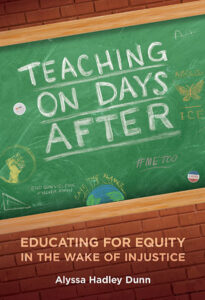Educating for Equity in the Wake of Injustice
Teaching on Days After: Educating for Equity in the Wake of Injustice
By Alyssa Hadley Dunn
(Teachers College Press, 2022 – Learn more)
Reviewed by Sarah Cooper

In Teaching on Days After, education professor Alyssa Hadley Dunn exhorts us to consider how the pedagogy we use on the “days after” such events reflects our teaching approach in general and affects the entire year with our students.

Reaching beyond social studies
Acknowledging that “little empirical research exists” about what she calls Days After Pedagogy (DAP), Dunn contributes to the field with this impressively researched book and assigns responsibility to all teachers.
Although “there is a large body of literature on teaching ‘controversial issues’ or ‘current events,” she writes, “this scholarship is largely confined to social studies. Here, as in previous work, I argue that teaching on days after extends beyond social studies and is possible – and necessary – across all grade levels and content areas.”
All the while, Dunn roots her pedagogical approach “in the theories and literature of social justice and liberatory education,” including asset-based pedagogies such as abolitionist, culturally sustaining, and trauma responsive teaching.
These approaches coalesce in a message repeated powerfully throughout the book: that Days After Pedagogy helps our students, and ourselves, “reach the full measure of their humanity.” In Dunn’s eyes, this kind of teaching is what we are put in the classroom to do.
Importantly, though, “Teaching on days after only works if you’ve been teaching for justice on days before and days during.” Her insistence that such conversations cannot be one-offs reminded me of Matt Kay’s admonition in the now-classic Not Light, But Fire: How to Lead Meaningful Race Conversations in the Classroom to embed such discussions throughout the year, rather than explode them in a “single shock and awe moment.”
Dunn also implores white teachers to step into the breach so that “colleagues of color should not be the only people tasked with talking about these issues.” In addition, regarding whether a Days After conversation is “relevant,” she asks, “But what happens when your students don’t know what they don’t know?”
And how do you navigate wide varieties in the knowledge students bring to class about these issues? One teacher, Gemma (a pseudonym) “remembers these lessons where she is ‘constantly trying to figure out what it looks like to help my white students deepen and develop understanding without keeping my students of color in 101 conversations,” and also without tokenizing students of color.
Addressing teachers’ concerns
You might be reading all of this and thinking of all the valid reasons you might not want to engage in these kinds of days after discussions.
Dunn addresses these fears throughout the book, starting out with questions teachers might have: “Indeed, many educators say they want to teach for justice on days after, but many express concerns and fears about doing this: How do I know what to do? What if parents or administrators are not happy with me addressing issues of injustice? What if my students are upset? What if some of my students feel one way and others feel differently; should I welcome all viewpoints? What do I do if I have mandated or scripted curriculum? How do I negotiate my own feelings in the process?”
At the end of the book she gives a series of strategies for engaging in DAP, and one of them is “to proactively anticipate pushback. This is not to make ourselves nervous about what is to come, but because all pedagogical decisions should have a clear rationale and purpose.”
The full list of advice, which she calls “by no means exhaustive,” reads:
1. Reject a call to ‘neutrality’
2. Remember students’ humanity
3. Remember that positionality and identity matter greatly
4. Establish community dialogue norms and agreements and reinforce them on days after
5. Collaborate
6. Prepare for pushback
a. Prepare a rationale statement
b. Remember your district’s mission and vision
c. Consider how you will practice your DAP
Full of meaningful research and narratives, Teaching on Days After will make you consider your stance in the classroom, the space you create for students, and who you are as a teacher and a person.
Sarah Cooper teaches eighth-grade U.S. history and is Associate Head of School at Flintridge Prep in La Canada, California, where she has also taught English Language Arts. Sarah is the author of Making History Mine (Stenhouse, 2009) and Creating Citizens: Teaching Civics and Current Events in the History Classroom (Routledge, 2017). She presents at conferences and writes for a variety of educational sites. You can find all of Sarah’s writing at sarahjcooper.com.






























